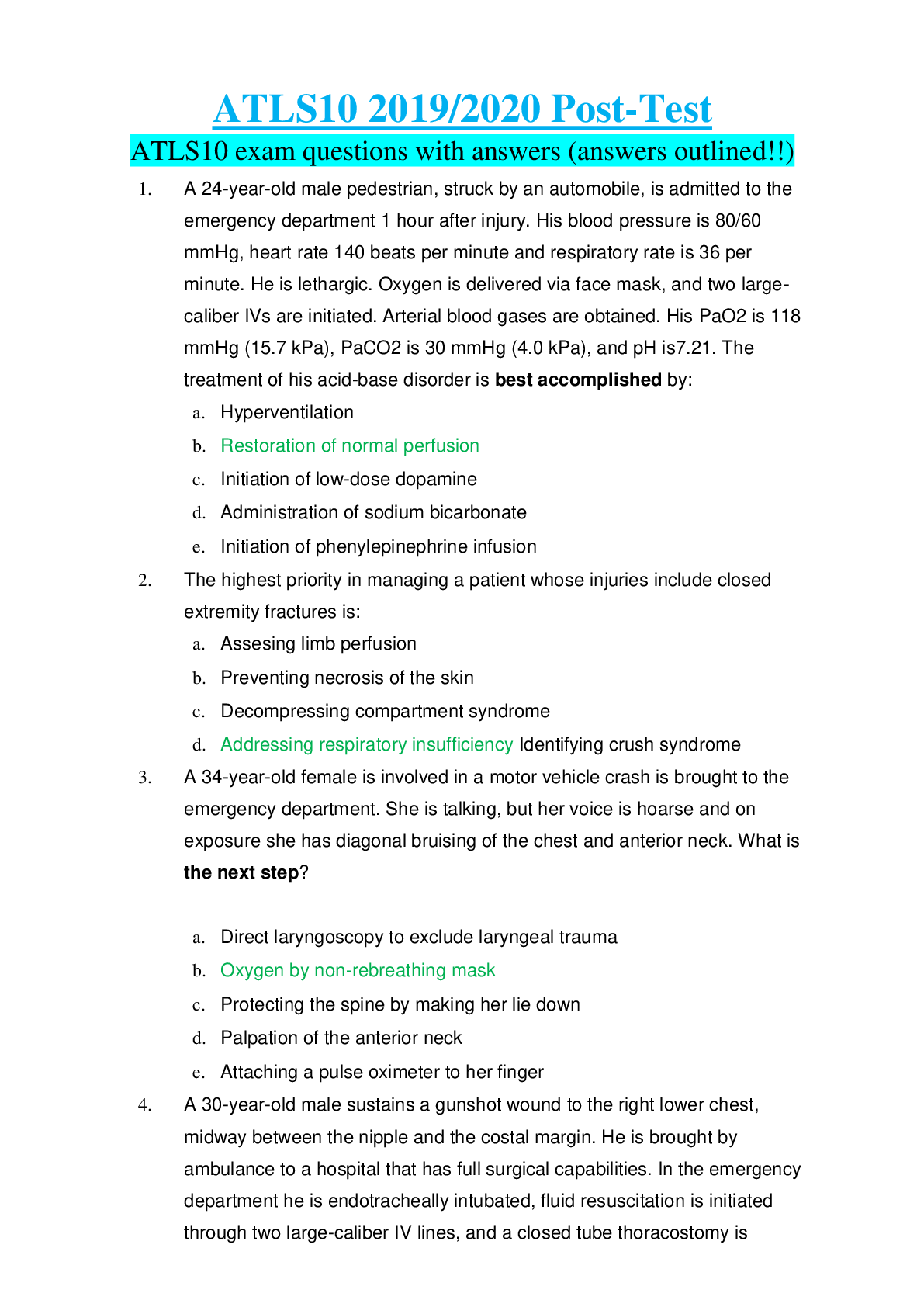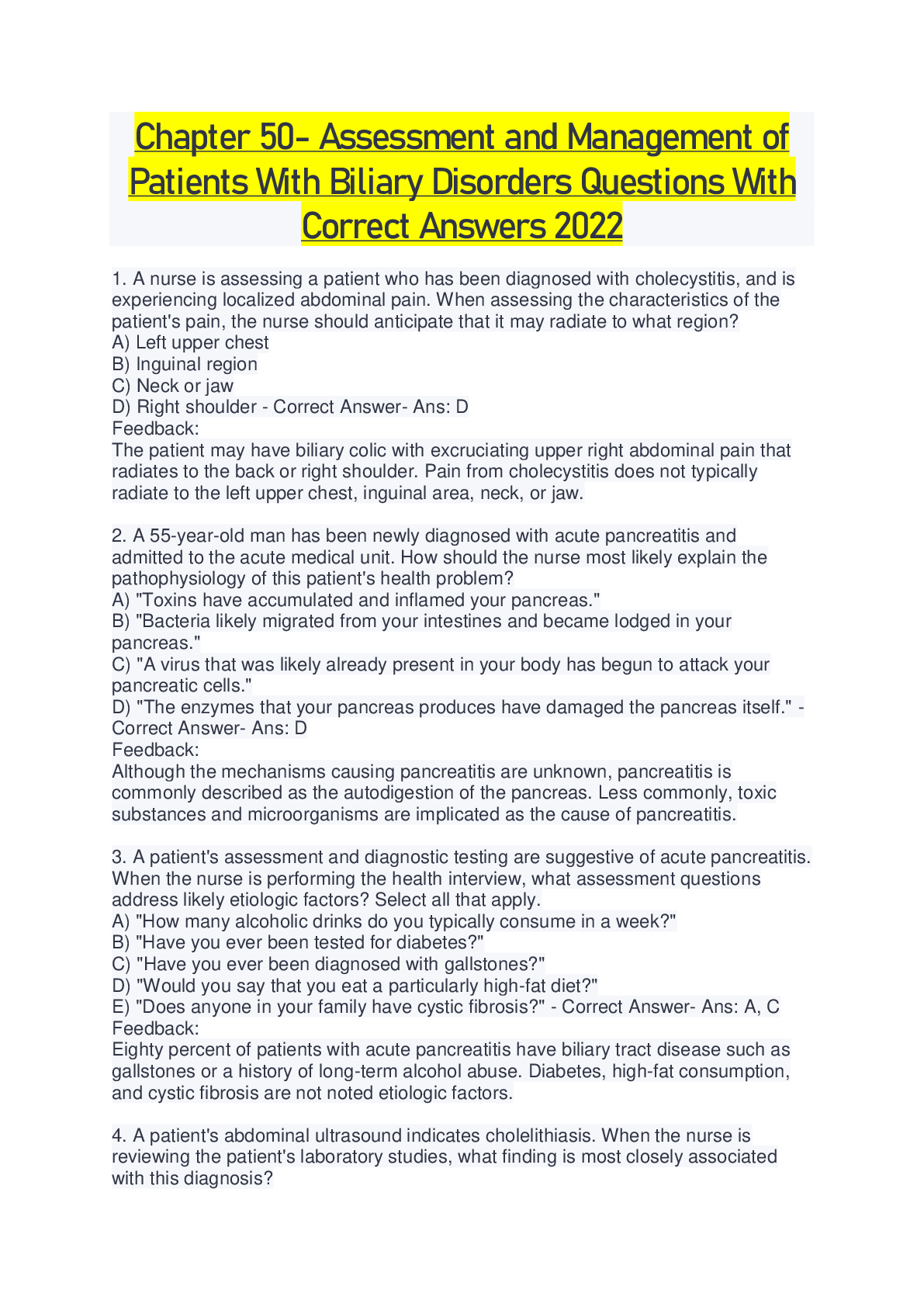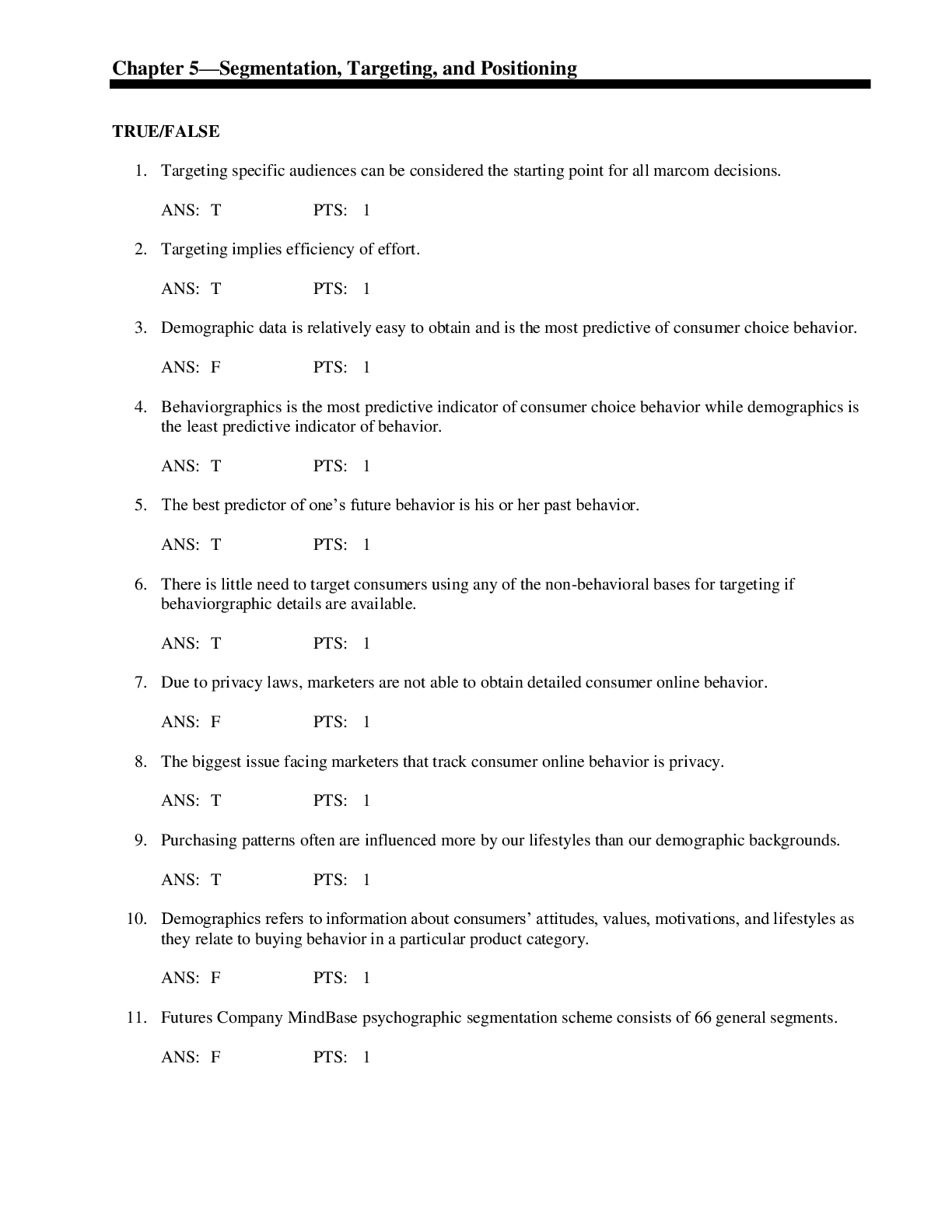*NURSING > QUESTIONS & ANSWERS > CHAPTER 57 – STROKE QUESTIONS AND ANSWERS 2022-2023 (All)
CHAPTER 57 – STROKE QUESTIONS AND ANSWERS 2022-2023
Document Content and Description Below
CHAPTER 57 – STROKE QUESTIONS AND ANSWERS 2022-2023 What topic should the nurse anticipate teaching a patient who had a brief episode of tinnitus, diplopia, and dysarthria with no residual effe... cts? a. Cerebral aneurysm clipping. b. Heparin intravenous infusion. c. Oral low-dose aspirin therapy. d. Tissue plasminogen activator (tPA). - Answer: c. Oral low-dose aspirin therapy. Rationale: The patient's symptoms are consistent with transient ischemic attack (TIA), and drugs that inhibit platelet aggregation are prescribed after a TIA to prevent a stroke. Continuous heparin infusion is not routinely used after TIA or with acute ischemic stroke. The patient's symptoms are not consistent with a cerebral aneurysm. tPA is used only for acute ischemic stroke, not for TIA. A patient is being admitted with a possible stroke. Which information from the assessment indicates that the nurse should consult with the health care provider before giving a prescribed dose of aspirin? a. The patient has dysphasia. b. The patient has atrial fibrillation. c. The patient reports that symptoms began with a severe headache. d. The patient has a history of brief episodes of right-sided hemiplegia. - Answer: c. The patient reports that symptoms began with a severe headache. Rationale: A sudden onset headache is typical of a subarachnoid hemorrhage, and aspirin is contraindicated. Atrial fibrillation, dysphasia, and transient ischemic attack are not contraindications to aspirin use. A patient being admitted with a stroke has right-sided facial drooping and right-sided arm and leg paralysis. Which finding should the nurse expect? a. Impulsive behavior. b. Right-sided neglect. c. Hyperactive left-sided tendon reflexes. d. Difficulty comprehending instructions. - Answer: d. Difficulty comprehending instructions. Rationale: Right-sided paralysis indicates a left-brain stroke, which will lead to difficulty with comprehension and use of language. The left-side reflexes are likely to be intact. Impulsive behavior and neglect are more likely with a right-side stroke. During change of shift report, a nurse is told that a patient has an occluded left posterior cerebral artery. What finding should the nurse anticipate? a. Dysphasia. b. Confusion. c. Visual deficits. d. Poor judgment. - Answer: c. Visual deficits. Rationale: Visual disturbances are expected with posterior cerebral artery occlusion. Aphasia occurs with middle cerebral artery involvement. Cognitive deficits and changes in judgment are more typical of anterior cerebral artery occlusion. What will the nurse tell the patient who has cerebral atherosclerosis about taking clopidogrel (Plavix)? a. Monitor and record the blood pressure daily. b. Call the health care provider if stools are tarry. c. Clopidogrel will dissolve clots in the cerebral arteries. d. Clopidogrel will reduce cerebral artery plaque formation. - Answer: b. Call the health care provider if stools are tarry. Rationale: Clopidogrel inhibits platelet function and increases the risk for gastrointestinal bleeding, so patients should be advised to notify the health care provider about any signs of bleeding. The medication does not lower blood pressure, decrease plaque formation, or dissolve clots. A patient with carotid atherosclerosis asks the nurse to describe a carotid endarterectomy. Which response by the nurse is accurate? a. "The diseased portion of the artery is replaced with a synthetic graft." b. "The obstructing plaque is surgically removed from inside an artery in the neck." c. "A wire is threaded through an artery in the leg to the clots in the carotid artery, and clots are removed." d. "A catheter with a deflated balloon is positioned at the narrow area, and the balloon flattens the plaque." - Answer: b. "The obstructing plaque is surgically removed from inside an artery in the neck." Rationale: In a carotid endarterectomy, the carotid artery is incised, and the plaque is removed. The response beginning, "The diseased portion of the artery is replaced" describes an arterial graft procedure. The answer beginning, "A catheter with a deflated balloon is positioned at the narrow area" describes an angioplasty. The final response beginning, "A wire is threaded through the artery" describes the mechanical embolus removal in cerebral ischemia (MERCI) procedure. A patient admitted with possible stroke has been aphasic for 3 hours and has a current blood pressure (BP) of 174/94 mm Hg. Which order by the health care provider should the nurse question? a. Keep head of bed elevated at least 30 degrees. b. Infuse normal saline intravenously at 75 mL/hr. c. Start a labetalol drip to keep BP less than 140/90 mm Hg. d. Begin tissue plasminogen activator (tPA) intravenously per protocol. - Answer: c. Start a labetalol drip to keep BP less than 140/90 mm Hg. Rationale: Because elevated BP may be a protective response to maintain cerebral perfusion, antihypertensive therapy is recommended only if mean arterial pressure (MAP) is greater than130 mm Hg or systolic pressure is greater than 220 mm Hg. Fluid intake should be 1500 to 2000 mL/day to maintain cerebral blood flow. The head of the bed should be elevated to at least 30 degrees unless the patient has symptoms of poor tissue perfusion. tPA may be administered if the patient meets the other criteria for tPA use. A patient arrives in the emergency department with hemiparesis and dysarthria that started 2 hours previously. Health records show a history of several transient ischemic attacks (TIAs). What should the nurse anticipate for this patient? a. Surgical endarterectomy. b. Transluminal angioplasty. c. Intravenous heparin drip administration. d. Tissue plasminogen activator (tPa) infusion. - Answer: d. Tissue plasminogen activator (tPa) infusion. Rationale: The patient's history and clinical manifestations suggest an acute ischemic stroke, and a patient who is seen within 4.5 hours of stroke onset is likely to receive tPA (after screening with a CT scan). Heparin administration in the emergency phase is not indicated. Emergent carotid transluminal angioplasty or endarterectomy is not indicated for the patient who is having an acute ischemic stroke. A female patient who had a stroke 24 hours ago has expressive aphasia. What is an appropriate nursing intervention to help the patient communicate? a. Ask questions that the patient can answer with "yes" or "no." b. Develop a list of words that the patient can read and practice reciting. c. Have the patient practice her facial and tongue exercises with a mirror. d. Prevent embarrassing the patient by answering for her if she does not respond. - Answer: a. Ask questions that the patient can answer with "yes" or "no." Rationale: Communication will be facilitated and less frustrating to the patient when questions that require a "yes" or "no" response are used. When the language areas of the brain are injured, the patient might not be able to read or recite words, which will frustrate the patient without improving communication. Expressive aphasia is caused by damage to the language areas of the brain, not by the areas that control the motor aspects of speech. The nurse should allow time for the patient to respond. What concern should the nurse anticipate for a patient who had a right hemisphere stroke?... [Show More]
Last updated: 2 years ago
Preview 1 out of 12 pages

Buy this document to get the full access instantly
Instant Download Access after purchase
Buy NowInstant download
We Accept:

Reviews( 0 )
$9.00
Can't find what you want? Try our AI powered Search
Document information
Connected school, study & course
About the document
Uploaded On
Sep 23, 2022
Number of pages
12
Written in
Additional information
This document has been written for:
Uploaded
Sep 23, 2022
Downloads
0
Views
75

























